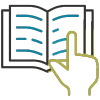LEAB QuickPass: Pass the Law Enforcement Aptitude Battery (LEAB) 2025 on Your First Try + Free Practice Test
- Practice Test
- Curriculum
- Sample Questions
- FAQs
- Reviews
Preparing for the Law Enforcement Aptitude Battery (LEAB)? This exam doesn’t just test knowledge—it measures judgment, problem-solving, and resilience under pressure. Many candidates fail, not for lack of potential, but for lack of preparation.
LEAB QuickPass gives you the edge. With realistic exam simulations, instant feedback, and strategies from law enforcement professionals, you’ll master the exam and enter the academy already ahead of the curve.
Free LEAB Practice Test
Ready for the LEAB? Prove It in 3 Minutes.
What is the LEAB?
The Law Enforcement Aptitude Battery (LEAB) is a crucial test for aspiring law enforcement officers. It’s divided into three parts: the Ability Test, Work Styles Questionnaire, and Life Experience Survey, and takes about 2.30 to 3 hours to complete. You have the freedom to use your time as you see fit across these sections, as they are not individually timed.
Let’s take a closer look at each of these parts of the test to get you confident for the test.
Success Stories
4.8 236 Reviews
rob, 16 Jan
Solid review course that covers the…
Solid review course that covers the relevant topics in good detail
chad, 11 Jan
Great Program, amazing practice simulations
Easy to understand. Passed tests on first time thru.
QUEEN RIGHTEOUS, 07 Jan
Highly recommended.Great instructional…
Highly recommended.Great instructional information. I passed on the first try.
Paprika Shikiso, 16 Dec
The EB Jacobs Law Enforcement Aptitude…
The EB Jacobs Law Enforcement Aptitude Battery (LEAB) Course really helps break down the different sections of the test in bite sized pieces. You really know what your going into before taking the test itself
MasterCommand, 14 Nov
Prepterminal. Prepare, practice, execute.
To say that Prepterminal helped me prepare and be ready for the testing phase would be an understatement. At first, looking at the course, I felt overwhelmed with the course material, but the course broke down each subject effectively which made it easier to understand. There were a few issues with some of the audio portion of the testing course, but beyond that, the course was well worth the money.
Abazix LLC, 09 Nov
Would recommend
Study material helped to pass my test on the first try.
LEAB Ability Test
The LEAB Ability Test measures Written Comprehension, Problem Sensitivity, and Reasoning with 48 multiple-choice questions (A to D). Every question is counted, and any left unanswered will be marked incorrect. Although the test is not strictly timed, you should plan to spend about two hours on this section unless instructed otherwise.
Let’s explore its key topics and sample questions.
Written Expression
Written Expression measures your ability to communicate clearly and accurately, with a focus on vocabulary and grammar. This skill is vital for drafting incident reports and writing letters to community members, where selecting the right words ensures your message is clear.
Here is an example question:
-
A:
I saw a broken car window and some teenagers nearby.
-
B:
The car has a broken window and windshield, and there are teenagers around.
-
C:
The teenagers seem to be involved with the damaged car.
-
D:
I noticed some broken glass in a car and teenagers hanging around.
Written Comprehension
Written Comprehension measures how well you understand written language, from vocabulary to the overall meaning of sentences. This skill is critical for interpreting arrest reports and following detailed instructions. On the test, you’ll read passages related to police work and answer questions to demonstrate your understanding.
Here is an example question:
Use the information in the following passage to answer questions that follow
Scenario: During a routine inspection at a local art gallery, Inspector Smith and Inspector Patel discovered that a valuable painting had gone missing. The gallery owner informed them that the painting, an original masterpiece, was stolen during a recent exhibition. The security footage showed a masked individual leaving the gallery with the painting concealed under their coat.
-
A:
It was damaged but not stolen.
-
B:
It was taken by a masked individual.
-
C:
It was hidden in the gallery.
-
D:
It was sold during the exhibition.
-
A:
Inspector Patel was the gallery owner.
-
B:
The painting was recovered during the inspection.
-
C:
The security footage showed a clear image of the thief's face.
-
D:
The gallery owner reported the missing painting after the exhibition ended.
Problem Sensitivity
Problem Sensitivity is the ability to recognize issues quickly, such as unreliable explanations or unusual conditions that need reporting. On the test, you’ll review narratives or witness statements and identify inconsistencies.
Here is an example question:
Scenario: Detective Sanchez interviewed multiple witnesses regarding a hit-and-run incident involving a red sports car. Each witness provided a description of the driver and the car:
Witness 1 - The driver was a Caucasian male in his late 40s with short, gray hair. He was wearing glasses and a blue suit.
Witness 2 - The driver appeared to be an elderly Caucasian man with white hair, possibly in his 60s. He had a beard and was wearing a green jacket.
Witness 3 - I saw a man driving the car. He looked like he was in his early 50s, had brown hair, and wore a black suit.
Witness 4 - The driver was a middle-aged man, probably in his 50s, with brown hair and a clean-shaven face. He wore a gray suit.
-
A:
4
-
B:
3
-
C:
2
-
D:
1
Deductive Reasoning
Deductive Reasoning is the ability to apply general rules to specific cases and draw logical conclusions. It is vital for distinguishing legal case types or making sound decisions. Test questions may ask you to categorize accidents using given standards.
Here is an example question:
Scenario: The local law enforcement agency has developed a detailed categorization system for incidents of vandalism within its jurisdiction to streamline response and investigative procedures.
The categories are as follows:
- Category A: Vandalism involving graffiti or tagging on public property or infrastructure.
- Category B: Vandalism causing damage to religious or cultural monuments, regardless of the financial cost of the damage.
- Category C: Vandalism to private property where the cost of damage is estimated to be less than $500.
- Category D: Vandalism to private property with damages exceeding $500 but less than $5,000.
When officers respond to a report of vandalism, they must evaluate the scene based on the above categories. Detailed reports should include photographic evidence, estimates of the damage, statements from witnesses, and any indications of the motive or bias that may influence the classification of the incident.
-
A:
Category A
-
B:
Category B
-
C:
Category C
-
D:
Category D
Inductive Reasoning
Inductive Reasoning is the ability to identify rules or patterns from specific situations. It helps in determining accident causes or recognizing criminal activity trends. On the test, you’ll be asked to spot similarities across events or objects.
Here is an example question:
Scenario: In December, Officer Gomez responded to a string of burglaries in the Oakwood neighborhood. The victims described the perpetrator with some variations but there were common threads. The descriptions are as follows:
- Burglary 1 (December 5) - Male, possibly Hispanic, mid-20s, roughly 5'9", approximately 160 pounds, short brown hair, seen wearing a red hoodie and jeans, sneakers.
- Burglary 2 (December 12) - Male, unidentified race, early 20s, around 6', about 170 pounds, curly black hair, reported to be wearing a dark jacket and cargo pants, and boots.
- Burglary 3 (December 18) - Male, possibly Hispanic or White, late 20s, about 5'10", nearly 165 pounds, dark short hair, observed in a grey sweatshirt and jeans, sneakers.
On December 22nd, a local resident noticed a suspicious individual lurking around a neighbor's property and promptly called the police. Officer Gomez arrived on the scene and detained the individual. The description of the suspect matched:
- Burglary 4 (December 22) - Male, Hispanic, mid-20s, 5'9", 160 pounds, brown hair, wearing a grey hoodie and jeans, sneakers.
-
A:
All previous burglaries.
-
B:
Burglary 1 only.
-
C:
Burglary 2 and 3 only.
-
D:
Burglary 1 and 3 only.
Information Ordering
Information Ordering is the ability to apply rules to arrange information in the proper sequence. It is key for prioritizing actions in emergencies or traffic accidents. On the test, you’ll be given procedures and must identify the next correct step.
Here is an example question:
Scenario: During a search operation in a building, police officers need to systematically search each floor for evidence or suspects. The following steps are used to ensure a thorough search. (These steps are NOT listed in the correct order.)
- Check under furniture and in closets for any evidence or hidden individuals.
- Mark the entrance of the floor with tape once it's cleared.
- Announce presence loudly before entering each room.
- Begin from the furthest point on the floor and move towards the entrance.
-
A:
3 > 4 > 1 > 2
-
B:
2 > 3 > 1 > 4
-
C:
4 > 3 > 1 > 2
-
D:
1 > 4 > 3 > 2
LEAB Work Styles Questionnaire
This section includes 102 statements about motivation, values, and attitude—qualities vital for success in law enforcement. You must answer every question on a scale from 1 to 5. It is recommended to spend about 20 minutes of the total 3 hours & 20 minutes on this part.
While there are no right or wrong answers, your responses play a key role in the selection process, making it important to familiarize yourself with the types of statements you’ll encounter.
Let’s look at a sample statement of the Work Styles Questionnaire:
LEAB Life Experience Survey
This part of the LEAB focuses on your past experiences through 96 questions, each with answer choices from A to E. Every question must be answered honestly, as incomplete or dishonest responses can lead to disqualification and may affect future interview questions.
Plan to spend about 45 minutes on this section. To prepare, review personal documents such as school records and resumes to ensure accurate responses.
Let’s look at some sample questions from this section:
Sample Question 1
Sample Question 2
Why Choose LEAB QuickPass?
Master the LEAB exam with tools designed for real success. From interactive practice to performance tracking, LEAB QuickPass equips you with everything needed to pass on the first try.
Comprehensive Content: LEAB QuickPass covers all sections of the LEAB test, including Written Expression, Written Comprehension, Problem Sensitivity, Deductive Reasoning, Inductive Reasoning, Information Ordering, and more.
Interactive Ability Test Practice: Get the advantage of interactive practice tests by topic, with detailed performance reports after each one. Our prep guides include sample questions and full mock tests to track progress and strengthen your test-taking skills.
Realistic Test Simulations: Experience realistic test simulations that mimic the actual LEAB exam conditions, helping you build confidence and reduce test-day anxiety.
Performance Analytics: Track your performance with detailed analytics and feedback. Identify areas for improvement and measure your progress over time.
Flexibility: LEAB QuickPass offers flexible schedules and on-demand access to materials, allowing you to study at your own pace and convenience on any device.
Up-to-date: LEAB QuickPass is frequently updated to stay current with any changes in the exam, ensuring that you receive the most relevant and up-to-date preparation.

LEAB QuickPass
Last Updated: Sep 09, 2025
Course Content
-
 Introduction 1 StepBuy this Course: Get full access to all lessons, practice tests and guides.
Introduction 1 StepBuy this Course: Get full access to all lessons, practice tests and guides. -
 Ability - Written Expression 4 StepsBuy this Course: Get full access to all lessons, practice tests and guides.
Ability - Written Expression 4 StepsBuy this Course: Get full access to all lessons, practice tests and guides. -
 Ability - Written Comprehension 5 StepsBuy this Course: Get full access to all lessons, practice tests and guides.
Ability - Written Comprehension 5 StepsBuy this Course: Get full access to all lessons, practice tests and guides. -
 Ability - Deductive Reasoning 4 StepsBuy this Course: Get full access to all lessons, practice tests and guides.
Ability - Deductive Reasoning 4 StepsBuy this Course: Get full access to all lessons, practice tests and guides. -
 Ability - Inductive Reasoning 4 StepsBuy this Course: Get full access to all lessons, practice tests and guides.
Ability - Inductive Reasoning 4 StepsBuy this Course: Get full access to all lessons, practice tests and guides. -
 Ability - Problem Sensitivity 4 StepsBuy this Course: Get full access to all lessons, practice tests and guides.
Ability - Problem Sensitivity 4 StepsBuy this Course: Get full access to all lessons, practice tests and guides. -
 Ability - Information Ordering 4 StepsBuy this Course: Get full access to all lessons, practice tests and guides.
Ability - Information Ordering 4 StepsBuy this Course: Get full access to all lessons, practice tests and guides. -
 Intro to WSQ & LES 1 StepBuy this Course: Get full access to all lessons, practice tests and guides.
Intro to WSQ & LES 1 StepBuy this Course: Get full access to all lessons, practice tests and guides. -
 Work Style Questionnaire 2 StepsBuy this Course: Get full access to all lessons, practice tests and guides.
Work Style Questionnaire 2 StepsBuy this Course: Get full access to all lessons, practice tests and guides. -
 Life Experience Survey 2 StepsBuy this Course: Get full access to all lessons, practice tests and guides.
Life Experience Survey 2 StepsBuy this Course: Get full access to all lessons, practice tests and guides.
Frequently Asked Questions (FAQs)
How hard is the LEAB?
The LEAB is difficult because it combines multiple components. The Ability Test features 48 multiple-choice questions on verbal, numerical, and logical reasoning, with only 2.5–3 hours to complete—unanswered questions are marked incorrect, adding time pressure.
The Work Styles Questionnaire and Life Experience Survey further assess motivations and past experiences, which can be subjective. Success often depends on thorough preparation with practice tests and study guides to build familiarity with the format and question types.
Which states use the LEAB?
The LEAB is used by Massachusetts, Pennsylvania, and New Jersey (where it’s called the Law Enforcement Examination or LEE). In New Jersey, it’s used for 13 different law enforcement titles including Police Officer, County Police Officer, Sheriff’s Officer, Parole Officer, and others.
How many questions are in each section of the LEAB?
- Massachusetts: 48 Ability Test questions, 103 Work Styles statements, 68 Life Experience questions
- Pennsylvania: 48 Ability Test questions, 66 Work Styles statements, 44 Life Experience questions
- PSI Version: 30 Ability Test questions, 135 Work Styles statements, 75 Life Experience questions
How many sections are in the LEAB?
The LEAB consists of three components administered in sequence:
- Ability Test
- Work Styles Questionnaire
- Life Experience Survey
What is the minimum passing score of the LEAB?
Massachusetts: You must achieve 70 or higher on the Ability Test to receive a LEAB score. If you score below 70 on the Ability Test, your Work Styles Questionnaire and Life Experience Survey responses will NOT be scored.
Pennsylvania and PSI: All three components will be scored and combined to determine continued eligibility. No specific minimum threshold mentioned.
How often is the LEAB administered?
The LEAB is offered periodically, but the frequency varies by state and agency. For example, New Jersey, Massachusetts, and Pennsylvania follow different schedules tied to recruitment cycles. Some agencies may hold the test multiple times a year, while others offer it less often based on hiring needs.
Candidates should check announcements from their local agencies for registration periods and test dates.
Can I retake the LEAB if I do not pass?
Yes. Retake policies vary by state and agency, but most allow multiple attempts. The number of retakes and required waiting period depend on local rules, and candidates may need to reapply and pay additional fees. Always confirm specific guidelines with the agency administering the exam.
What happens if I answer a question incorrectly on the LEAB Test?
In the Ability Test, incorrect answers simply don’t earn points—there’s no additional penalty. To maximize your score, aim to answer as many questions correctly as possible. In the Life Experience Survey and Work Styles Questionnaire, there are no right or wrong answers, but responses are evaluated for consistency and alignment with law enforcement traits. Honest, consistent answers are key to performing well.

Created by: Michael Lerner
BSc, Psychometric Tutor, Prepterminal Test Expert
1426 students, 4.8, 236 Reviews
Hey, I’m Michael, PrepTerminal’s Law Enforcement expert. I am here to help you with any questions or concerns you may have about the Law Enforcement Aptitude Battery Course. Feel free to contact me at [email protected].
